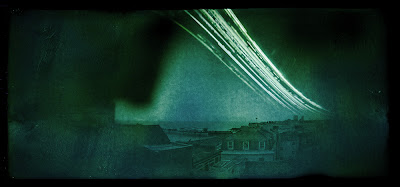Following Mike Oddhayward's thread in the Brighton Analogue Flickr group, Mike Oddhayward, Simon Tomlinson and myself met in Add The Colour to make some pinhole cameras for solargraphy. We were later joined by Nadine Burzler and Graham Lally. The materials and tools needed are very simple and readily available:
- drinks cans and film canisters for the camera bodies
- scissors
- matt black paint
- paintbrush
- strong waterproof tape
- needle
- B&W photographic paper
Using a drinks can:
1. Cut the top off the can, leaving the rim intact
2. Cut an approx 1cm x 1cm hole in the front of the can.
3. Paint the inside of the can with matt black paint.
4. From a different can, cut a piece of tin approx 3cm x 3cm.
5. With a very fine needle, pierce the centre of the 3cm x 3cm piece of tin with the tiniest of holes. We found placing the piece of tin on a hard table and lightly tapping the end of the needle with a knife handle was all it took. The hole was barely visible to the naked eye and could only be seen when the piece of tin was held up to the light.
6. Tape the 3cm x 3cm piece of tin over the 1cm x 1cm hole, making sure the pinhole is in the middle of the 1cm x 1cm hole. Shiney metal surface to the outside. (For clarity the tape is not shown).
7. It is crucial that all taping is extremely thorough to ensure there is no water ingress at all. We used electrical tape around the 3cm x 3cm piece of tin, see below.
8. That's the camera made, now to insert the photographic paper and seal the camera.
9. First, make a tape 'patch' that will be placed on the top of the can once the paper has been inserted. We used silver Duck Tape, but found in use that it weathered quite badly. On our next cameras we intend to use Flashband or similiar construction waterproofing tape.
10. The next step is to insert the photographic paper into the can. We used Ilford Multigrade lV, resin coated, pearl finish, photographic paper. Prior to going into a darkroom we cut a template for the photographic paper with a sheet of normal paper. This makes it much easier to cut the photographic paper once in the darkroom. The photographic paper, shown blue on the left diagram below, should go round the inside of the can, leaving a gap about 2cm wide where the pinhole is. Vertically the paper should be the height of the flat part of the can, see the diagram on the right below.
11. Put a small piece of tape over the pinhole to prevent light entering at this stage.
12. Take the following into the darkroom with you:
- can camera
- tape patch
- photographic paper
- scissors
- paper template
13. Once in the darkroom with the red safelight on,
- Take the photographic paper out of its protective bag, and using the paper template, cut it to the correct size.
- Carefully place the photographic paper into the can camera with the active side facing into the middle of the can. Make sure the paper has not obscured the pinhole. Although we didn't do it this time, we will almost certainly tape the photographic paper in place by its corners, to make sure there is no chance of it moving and obscuring the pinhole when being carried around. This would be very important with larger pinhole cameras.
- Put the tape patch over the cut end of the can camera and carefully dress the tape down the sides of the can, making sure the can camera is completely light tight.
14. You can now leave the darkroom.
15. We completely covered the can cameras with Duck Tape, see below, to make sure there would be no water ingress through either the cut end of the can or around the piece of tin that forms the pinhole.
The principle is exactly the same with the film canisters.
The cameras were now finished! We were very happy and excited about the next stages of this project, installing the cameras and seeing if they worked!
It took a few hours to make about 6 cameras but we were chatting alot and experimenting as we went. Now that we have a better idea of what we were doing I would say one person could make 3 cameras in about an hour with a bit of a production line going.
Simon Tomlinson and Nadine Burzler also made cameras but I'm not sure if they have installed them anywhere yet. It would be great to see your results if you have.
















